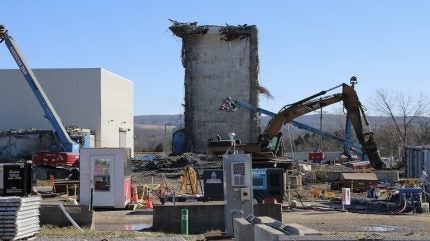
US Department of Energy (DOE) Office of Environmental Management (EM) crews at the West Valley Demonstration Project have safely removed a concrete cell used during legacy nuclear fuel reprocessing operations as they continue work on the Main Plant Process Building demolition.
The Main Plant is one of the last remaining major facilities at West Valley and the teardown is 88% complete. Its successful demolition will further reduce environmental risks and position the site for the next phase in clean-up. The demolition began in September 2022 and is expected to be completed early this summer.
The Off-Gas Cell had housed ventilation equipment for the Main Plant’s many tanks and vessels, as well as a condenser for a low-level waste evaporator. The steel-reinforced concrete cell was 366 square feet in size with a ceiling height of 29 feet. Its walls varied in size from 2 feet to 5 feet thick.
During legacy fuel reprocessing operations, a leak of acid contaminated the cell’s northwest corner, requiring special demolition techniques to bring a portion of the cell wall to the ground.
“Safety comes down to planning, preparation and safe execution of work,” EM West Valley Main Plant Project Director Stephen Bousquet said. “Our team worked together to carefully plan the controlled demolition of this cell while ensuring structural integrity and keeping contamination at its source.”
The Product Purification Cell, a highly contaminated cell resembling an elevator shaft, can now be seen clearly following the recent removal of the 366-square-foot Off-Gas Cell. One special demolition technique involved crews painting lines from top to bottom on the outside of the cell to highlight the areas to be demolished. These lines guided the operator to remove small sections of the structure in a deliberate, controlled manner.
Workers deployed two pieces of equipment to safely and compliantly remove each cell section from top to bottom. An operator used a hydraulic hammer to chisel around a section and free it from the steel reinforcement. Using a grapple, or claw, attachment, a second operator grabbed the section and lowered it to the ground for packaging. Crews ran misters during the work to control dust at its source.
“Interdisciplinary collaboration and lessons learned from previous demolition activities has been an excellent combination for safety and success,” said Tom Dogal, facility disposition manager for CH2M HILL BWXT West Valley, EM’s cleanup contractor at the site. “This work evolution was executed without incident or unplanned radiological releases, and I am very proud of our team.”
The West Valley Demonstration Project (WVDP) is an approximate 150-acre area located 35 miles south of Buffalo, New York. The site, owned by the New York State Energy Research & Development Authority, is home to the only commercial used nuclear fuel reprocessing facility to operate in the United States. Operating from 1963 to 1972, the site processed 640 tonnes of used nuclear fuel and generated over 600,000 gallons of liquid high-level waste. In 1980, Congress passed the WVDP Act, which required DOE to conduct a high-level waste management demonstration project at the site and transport it to a federal repository for disposal.






